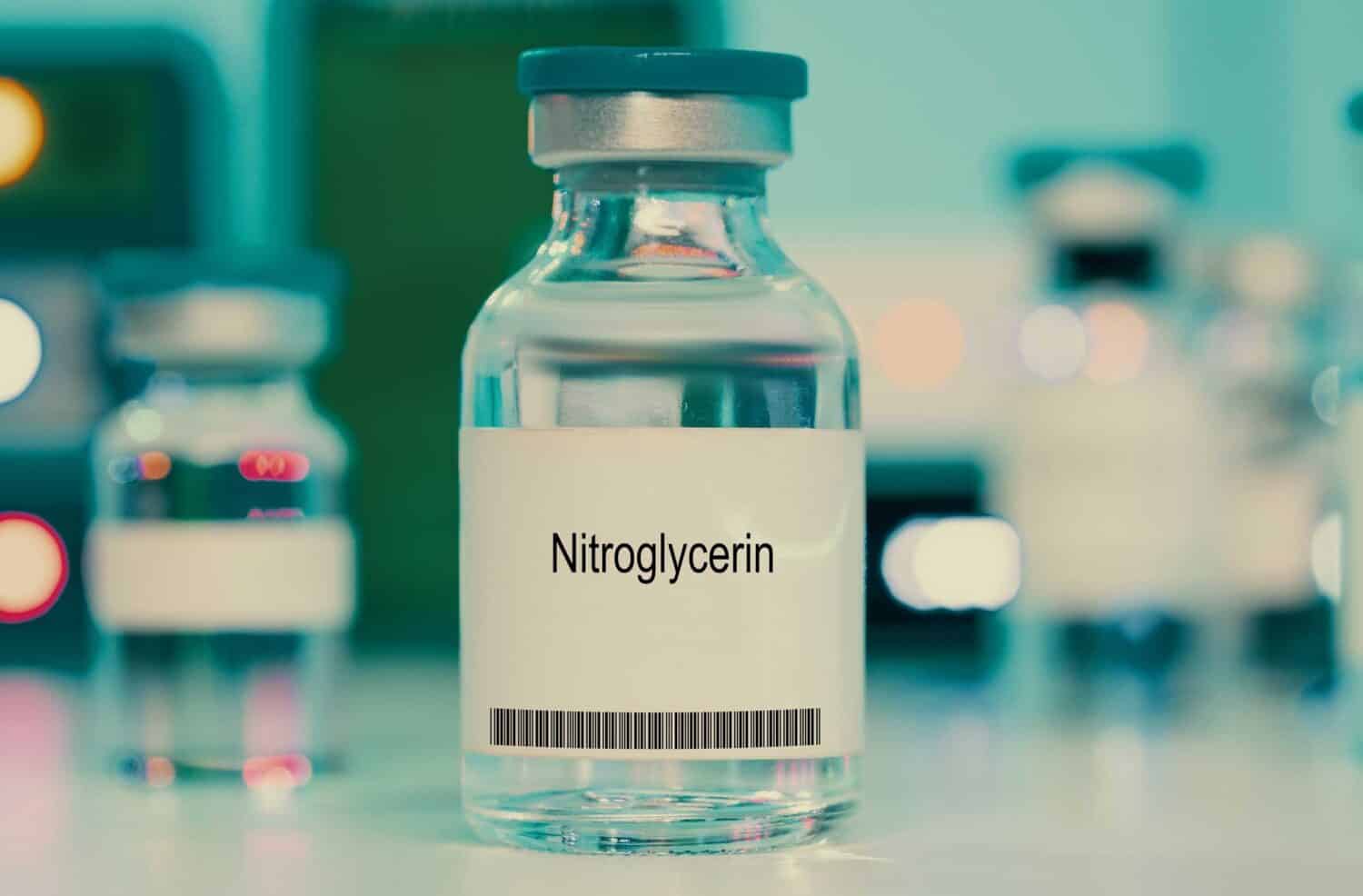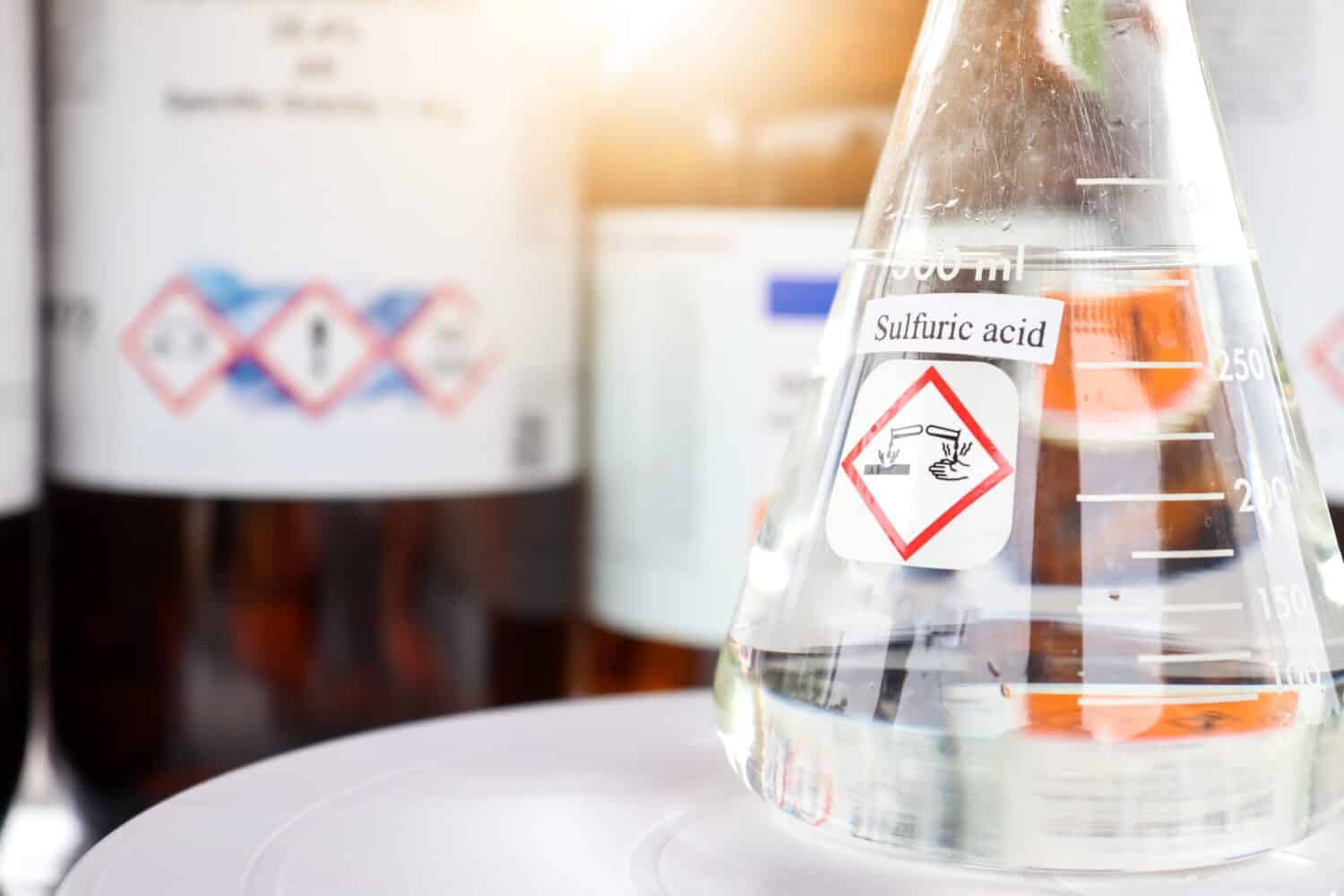In chemistry, some substances wield extraordinary power when it comes to ionizing in aqueous solutions, and they go by the name “strong acids.” These chemical compounds possess a unique ability to donate protons, making them highly corrosive and capable of causing severe burns. Discover what the six strong acids are and examine their names, constituent elements, and the reasons behind their formidable reputation in the world of chemistry.

Hydrogen is present in all acids.
©sulit.photos/Shutterstock.com
What Are Strong Acids?
Strong acids are a category of chemical compounds known for their exceptional ability to donate protons (H+ ions) when dissolved in water. This property results in high ionization, making them powerful and highly reactive in aqueous solutions. These acids are corrosive, and corrosiveness measures their ability to lower pH significantly. Additionally, corrosiveness plays an essential role in various chemical reactions.
How Are Strong Acids Measured?
The pKa value is a crucial parameter used to measure the strength of an acid, including strong acids. The pKa value of an acid is a numerical representation of its strength. For strong acids, the pKa value is exceptionally low, typically well below 0. This low pKa shows that strong acids tend to donate protons (H+ ions) when dissolved in water.
A lower pKa value corresponds to a stronger acid. Furthermore, strong acids almost completely ionize in water, resulting in a high concentration of hydronium ions (H3O+) and a very low pH in the solution.
The 6 Strong Acids
Six strong acids hold a prominent place in the world of chemistry: Hydrochloric acid (HCl), sulfuric acid (H2SO4), nitric acid (HNO3), hydrobromic acid (HBr), hydroiodic acid (HI), and perchloric acid (HClO4). Furthermore, these six strong acids exhibit the ability to dissociate in water completely, leading to a high concentration of hydronium ions (H3O+) and playing a crucial role in various chemical applications.
1. Hydrochloric Acid (HCl)
Elements:
- Hydrogen (H)
- Chlorine (Cl)
pKa: -6.3
Hydrochloric Acid, often represented by its chemical formula HCl, is one of the most recognizable strong acids outside of the chemical world. Comprising hydrogen and chlorine atoms, this colorless liquid compound is highly corrosive, and experts use it in both industrial and laboratory contexts.
When introduced into an aqueous solution, hydrochloric acid showcases its inherent strength as a strong acid by undergoing complete ionization. This ionization process yields a high concentration of hydronium ions (H3O+) and chloride ions (Cl-). This attribute also underscores its critical role in various chemical reactions, and the complete ionization leads to a considerably low pH level, usually close to zero, indicating its potent acidic nature.
Applications of HCl
Notably, like chemistry, hydrochloric acid also plays a pivotal role in biology. It is a key component of gastric acid in the human digestive system, aiding in the breakdown of ingested food. Its corrosive properties assist digestion.
In the industrial sphere, hydrochloric acid serves as an effective agent in metal cleaning processes, plays a vital role in ore processing, and also finds extensive use in the production of numerous chemicals and pharmaceuticals. Its ability to dissolve various substances makes it indispensable in various sectors.
2. Sulfuric Acid (H2SO4)
Elements:
- Hydrogen (H)
- Sulfur (S)
- Oxygen (O)
pKa1: -3
pKa2: 1.9
Chemically represented as H2SO4, sulfuric acid comprises hydrogen (H), sulfur (S), and oxygen (O) atoms. Scientists refer to this strong acid as the “King of Chemicals” thanks to its widespread utility.
This colorless, oily liquid boasts a unique dual dissociation process in aqueous solutions, meaning it can donate two protons (H+) sequentially. The first dissociation yields a hydronium ion (H3O+) and a hydrogen sulfate ion (HSO4-). The second dissociation further releases a proton, resulting in the formation of a sulfate ion (SO4^2-).
This dual dissociation process underlines the remarkable strength and acidity of sulfuric acid, as reflected in its pKa values. Sulfuric Acid has pKa values of approximately -3 for the first dissociation and 1.9 for the second dissociation. These values are low, indicating its strong acidic nature.
Applications of H2SO4
Sulfuric acid finds application in various industrial processes, including battery manufacturing, where it serves as the electrolyte in lead-acid batteries. It also plays a crucial role in oil refining, as well as in the production of fertilizers, explosives, and various chemicals. Additionally, manufacturers use it for metal cleaning, wastewater treatment, and as a dehydrating agent in numerous chemical reactions.

Nitric acid is used to make nitroglycerin, a main component of explosives like TNT.
©luchschenF/Shutterstock.com
3. Nitric Acid (HNO3)
Elements:
- Hydrogen (H)
- Nitrogen (N)
- Oxygen (O)
pKa: -1.3
Comprising hydrogen (H), nitrogen (N), and oxygen (O) atoms, nitric acid has versatile applications. One of the defining features of nitric acid is its low pKa value, which is approximately -1.3. Nitric acid is a colorless to slightly yellow liquid and is also a powerful oxidizing agent.
Applications of HNO3
The strong acid’s primary use lies in the production of fertilizers, particularly ammonium nitrate, a key component. Experts also use it in the manufacturing of explosives, such as nitroglycerin and TNT, because of its capacity to facilitate exothermic reactions.
In laboratories, nitric acid serves as a valuable reagent for various analytical and synthetic procedures. Scientists also frequently use it in the process of dissolving metals, making it indispensable for metal etching and as a cleaning agent for laboratory glassware.
Furthermore, the fuming form of nitric acid, known as white-fuming nitric acid, contains nitrogen dioxide (NO2) and is especially potent as an oxidizer and nitrating agent. Scientists use this variant in more specialized applications, such as rocket propulsion and the production of certain explosives.
4. Hydrobromic Acid (HBr)
Elements:
- Hydrogen (H)
- Bromine (Br)
pKa: -9
Hydrobromic acid is less well-known outside of the chemical world. Composed of hydrogen (H) and bromine (Br) atoms, this colorless liquid compound plays a vital role in both laboratory research and industrial processes. It is also an essential reagent in many chemical reactions.
When dissolved in water, hydrobromic acid ionizes, releasing protons (H+) into the solution, leading to a lower pH. Its pKa value is approximately -9, indicating a very strong tendency to donate protons.
Applications of HBr
In laboratories, hydrobromic acid finds use in organic synthesis and as a catalyst for certain reactions. It is also valuable in preparing bromine-containing compounds, where its bromide ions play a pivotal role.
In industrial applications, hydrobromic acid contributes to various processes, such as the production of pharmaceuticals and the synthesis of organic chemicals. The electronics industry also uses the strong acid for etching semiconductor materials.
5. Hydroiodic Acid (HI)
Elements:
- Hydrogen (H)
- Iodine (I)
pKa: -10
Hydroiodic acid, represented as HI, is a powerful and highly reactive compound. It is an exceptionally strong acid with a pKa value of -10. It is a colorless liquid and also one of the strongest known acids. Furthermore, its remarkable acidity makes it valuable for organic synthesis and chemical transformations.
Applications of HI
In laboratory contexts, hydroiodic acid serves as a valuable reagent in various chemical reactions, particularly in organic synthesis. Its unique reactivity, driven by the propensity to donate protons, makes it indispensable for preparing iodine-containing compounds and for specific chemical transformations.
The compound also finds application in industrial processes, including the production of pharmaceuticals and chemicals. Its role as a reducing agent in certain chemical reactions adds to its versatility.
6. Perchloric Acid (HClO4)
Elements:
- Hydrogen (H)
- Chlorine (Cl)
- Oxygen (O)
pKa: -10
Perchloric acid, HClO4, is a potent and distinctive member of the strong acids, known for its unique properties and wide-ranging applications. Comprising hydrogen (H), chlorine (Cl), and oxygen (O) atoms, this colorless liquid has a pKa value of approximately -10, making it highly acidic.
Perchloric acid is extremely stable and does not react with many common substances, including glass and certain metals. This unique property makes it invaluable in analytical chemistry, where it is used to prepare solutions for titrations and other analytical techniques.
Applications of HClO4
In laboratory settings, perchloric acid serves as a versatile reagent for various chemical reactions and as a strong oxidizing agent. Its stability, along with its high purity, contributes to its importance in chemical research.
Manufacturers also use HCLO4 as an electrolyte in certain electrochemical cells and batteries, where its high ionic conductivity contributes to the efficient flow of charges. Additionally, in the aerospace industry, perchloric acid is a component in rocket propellants and fuels thanks to its high reactivity and energy release.

When reacting with active metals, acids produce hydrogen gas.
©RHJPhtotos/Shutterstock.com
Characteristics of Strong Acids
Strong acids have several distinctive features and properties, which set them apart from weak acids and make them important in various chemical processes. The key characteristics of strong acids include:
- Complete ionization: Strong acids undergo complete ionization when dissolved in water. All of the acid molecules donate their protons (H+ ions) to water molecules, leading to a high concentration of hydronium ions (H3O+) in the solution.
- Low pH: Strong acids exhibit a very low pH value (usually close to zero).
- Low pKa value: Strong acids also have low pKa values, often significantly below 0. The pKa value quantifies the strength of an acid, with lower values indicating stronger acids.
- High reactivity: These acids are highly reactive substances. Their ability to donate protons makes them effective catalysts in many chemical reactions.
- Corrosiveness: They are corrosive and can react with a wide range of materials, including metals, organic compounds, and even some non-metals. Their corrosive nature makes them valuable for tasks such as metal cleaning and etching.
- Conductivity: Strong acids are strong electrolytes and conduct electricity well when dissolved in water because of their high concentration of ions.
Naming Strong Acids
The naming of strong acids follows a specific convention in chemistry. It involves specifying the name of the anion (the negatively charged ion) formed when the acid dissociates in water, along with the word “acid.” The general rules for naming strong acids are:
- Prefix (Hydro-): The names of strong acids usually begin with the prefix “hydro-” followed by the name of the root non-metal element. Scientists use this naming convention for binary acids, which comprise hydrogen and a single non-metal.
- Suffix (-ic Acid): After the “hydro-” prefix, you add the suffix “-ic acid” to the name of the non-metal element. This shows that the acid is a binary acid.
- Hydrogen: in the acid’s formula, hydrogen (H) is always present, so experts do not explicitly mention it in the name.
Examples of strong acids and their naming based on these rules:
- HCl: Hydrochloric Acid
- HBr: Hydrobromic Acid
- HI: Hydroiodic Acid
Polyatomic Strong Acids
For strong acids that contain polyatomic ions (those with over two elements), the naming convention is different. You typically use the name of the polyatomic ion, followed by the word “acid.”
Examples of polyatomic strong acids:
- H2SO4: Sulfuric Acid (from the sulfate ion, SO4^2-)
- HNO3: Nitric Acid (from the nitrate ion, NO3-)
The Potent Impact of Strong Acids
Strong acids, characterized by their remarkable acidity and ability to dissociate completely in water, play a pivotal role in chemistry and industry. Their low pKa values, high reactivity, and diverse applications make them indispensable in various chemical processes, from laboratory research to industrial manufacturing.
These strong acids, including hydrochloric acid, sulfuric acid, nitric acid, hydrobromic acid, hydroiodic acid, and perchloric acid, each possess unique properties and applications. From titrations and chemical syntheses to metal cleaning and rocket propulsion, strong acids leave an important mark on countless fields of science and technology.
Thank you for reading! Have some feedback for us? Contact the AZ Animals editorial team.








